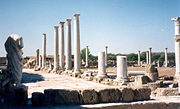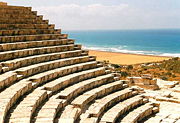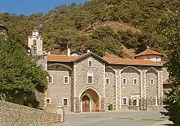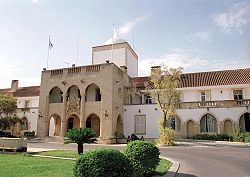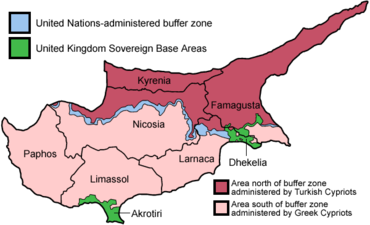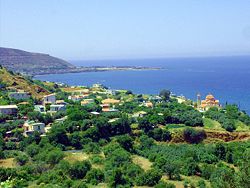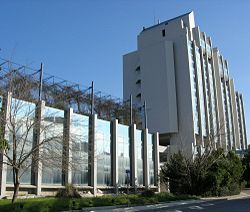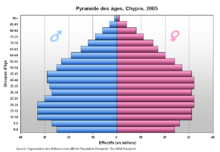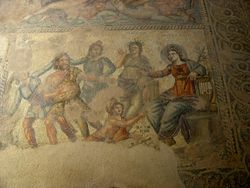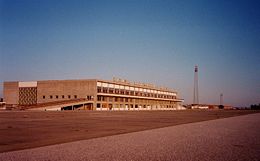Cyprus
2008/9 Schools Wikipedia Selection. Related subjects: Europe; European Countries
| Κυπριακή Δημοκρατία ( Greek) Kypriakḗ Dēmokratía Kıbrıs Cumhuriyeti ( Turkish) Republic of Cyprus
|
||||||
|---|---|---|---|---|---|---|
|
||||||
| Anthem: Ὕμνος εἰς τὴν Ἐλευθερίαν Ymnos is tin Eleftherian Hymn to Liberty1 |
||||||
 Location of Cyprus (dark green)
– on the European continent (light green & dark grey) |
||||||
| Capital (and largest city) |
Nicosia (Lefkosia, Lefkosa) |
|||||
| Official languages | Greek, Turkish | |||||
| Demonym | Cypriot | |||||
| Government | Presidential republic | |||||
| - | President | Dimitris Christofias | ||||
| Independence | from the UK | |||||
| - | Date | 1 October 1960 | ||||
| EU accession | 1 May 2004 | |||||
| Area | ||||||
| - | Total | 9,251 km² ( 167th) 3,572 sq mi |
||||
| - | Water (%) | negligible | ||||
| Population | ||||||
| - | 2007 census | 788,457 | ||||
| - | Density | 85/km² ( 85th) 221/sq mi |
||||
| GDP ( PPP) | 2007 IMF estimate | |||||
| - | Total | $21.382 billion ( 108th) | ||||
| - | Per capita | $27,429 ( 29th) | ||||
| GDP (nominal) | 2007 IMF estimate | |||||
| - | Total | $21.303 billion ( 87th) | ||||
| - | Per capita | $27,327 ( 28th) | ||||
| Gini (2005) | 29 (low) | |||||
| HDI (2007) | ▲ 0.903 (high) ( 28th) | |||||
| Currency | Euro ( EUR) |
|||||
| Time zone | EET ( UTC+2) | |||||
| - | Summer ( DST) | EEST ( UTC+3) | ||||
| Internet TLD | .cy3 | |||||
| Calling code | +357 | |||||
| 1 | Also the national anthem of Greece. | |||||
| 2 | Before 2008: Cypriot pound | |||||
| 3 | The .eu domain is also used, shared with other European Union member states. | |||||
Cyprus ( Greek: Κύπρος, Kýpros; Turkish: Kıbrıs), officially the Republic of Cyprus ( Greek: Κυπριακή Δημοκρατία, Kypriakḗ Dēmokratía; Turkish: Kıbrıs Cumhuriyeti) is a Eurasian island country situated in the eastern Mediterranean south of Turkey, west of the Levant, north of Egypt, and east-southeast of Greece.
Cyprus is the third-largest Mediterranean island and one of the most popular tourist destinations, attracting over 2.4 million tourists per year. A former British colony, it gained independence from the United Kingdom in 1960 and became a Commonwealth republic in 1961. The Republic of Cyprus is a developed country and has been a member of the European Union since 1 May 2004. It adopted the euro on 1 January 2008.
In 1974, following a period of violence between Greek Cypriots and Turkish Cypriots and an attempted Greek Cypriot coup d'état aimed at annexing the island to Greece and sponsored by the Greek military junta of 1967-1974, Turkey invaded and occupied one-third of the island. This led to the displacement of thousands of Cypriots and the establishment of a separate Turkish Cypriot political entity in the north. This event and its resulting political situation is a matter of ongoing dispute.
The Republic of Cyprus, the internationally recognized state, claimed sovereignty over 97% of the island of Cyprus and all surrounding waters, with the United Kingdom controlling the remaining three percent. The island is de facto partitioned into four main parts:
- the area under the effective control of the Republic of Cyprus in the south of the island;
- the Turkish-occupied area in the north, calling itself the Turkish Republic of Northern Cyprus ( recognized only by Turkey);
- the United Nations -controlled Green Line, separating the two; and
- two Sovereign Base Areas (Akrotiri and Dhekelia), over which the United Kingdom retained jurisdiction after Cypriot independence.
Etymology
The name 'Cyprus' has a somewhat uncertain etymology. One suggestion is that it comes from the Greek word for the Mediterranean cypress tree ( Cupressus sempervirens), κυπάρισσος (kypárissos), or even from the Greek name of the henna plant ( Lawsonia alba), κύπρος (kýpros). Another school suggests that it stems from the Eteocypriot word for copper. Georges Dossin, for example, suggests that it has roots in the Sumerian word for copper (zubar) or for bronze (kubar), from the large deposits of copper ore found on the island. Through overseas trade the island has given its name to the Classical Latin word for the metal through the phrase aes Cyprium, "metal of Cyprus", later shortened to Cuprum. Cyprus is also called "the island of Aphrodite" , since the Greek goddess Aphrodite, of beauty and love, was born in Cyprus. The most common theory is that it came from their word for copper, Kypros, because the island had rich deposits of copper.
History
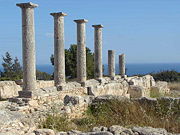
Cyprus is the mythical birthplace of Aphrodite, Adonis and home to King Cinyras, Teucer and Pygmalion. The earliest confirmed site of human activity is Aetokremnos, situated on the south coast, indicating that hunter-gatherers were active on the island from around 10,000 BC, with settled, village communities dating from 8200 BC. Important remains from this early- Neolithic period can be found at Shillourokambos, Kastros, and Khirokitia, where decorated pottery and figurines of stone quite distinct from the cultures of the surrounding mainland survive. The Mycenaean Greeks first reached Cyprus around 1600 BC, with settlements dating from this period scattered all over the island. Another wave of Greek settlement is believed to have taken place in the period 1100-1050 BC, with the island's predominantly Greek character dating from this period. Several Phoenician colonies were founded in the 8th century BC, like Kart-Hadasht ('New Town'), near present day Larnaca and Salamis
Cyprus was conquered by Assyria in 709 BC, before a brief spell under Egyptian rule and eventually Persian rule in 545 BC. Cypriots, led by Onesilos, joined their fellow-Greeks in the Ionian cities during the unsuccessful Ionian Revolt in 499 BC against the Achaemenid Empire. The island was brought under permanent Greek rule by Alexander the Great and the Ptolemies of Egypt following his death. Full Hellenization took place during the Ptolemaic period, which ended when Cyprus was annexed by Roman Republic in 58 BC. Cyprus was one of the first stops in apostle Paul's missionary journey. In 395 AD it became part of the Byzantine Empire, which lost it temporarily to the Arabs in 643 AD before reclaiming it in 966 AD.
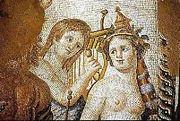
Richard I of England captured the island in 1191 during the Third Crusade, using it as a major supply base that was relatively safe from the Saracens. A year later Guy of Lusignan purchased the island from the Templars to compensate the loss of his kingdom.
The Republic of Venice seized control of the island in 1489 after the abdication of Queen Caterina Cornaro, the widow of James II, the last Lusignan king of Cyprus. Using it as an important commercial hub, Venetians soon fortified Nicosia, the capital and most important city, with its famous Venetian Walls. Throughout Venetian rule, the Ottoman Empire frequently raided Cyprus. In 1539 the Ottomans destroyed Limassol. Fearing the worst, the Venetians fortified Famagusta, Nicosia, and Kyrenia.
In 1570, a full scale conquest under Piyale Pasha with 60,000 troops brought the island under Ottoman control, despite stiff resistance by the inhabitants of Nicosia and Famagusta. The Ottomans applied the millet system and allowed religious authorities to govern their own non- Muslim minorities, but at the same time invested the Orthodox Church as a mediator between Christian Cypriots and the authorities granting it not only religious but political and economic powers. Heavy taxation led to rebellions - between 1572 and 1668, around twenty-eight bloody uprisings took place - forcing the Sultan to intervene. The first large-scale census of the Ottoman Empire in 1831, counting only men, showed 14,983 Muslims and 29,190 Christians. By 1872, the population of the island had risen to 144,000 comprising 44,000 Muslims and 100,000 Christians.
Administration (but not sovereignty) of the island was ceded to the British Empire in 1878, in the aftermath of the Russo-Turkish War (1877–1878). The island would serve Britain as a key military base in its its colonial routes. By 1906, when the Famagusta harbour was completed, Cyprus was a strategic naval outpost overlooking the Suez Canal, the crucial main route to India, then Britain's most important colony. Following World War 1 and the Ottoman alliance with the Central powers, the United Kingdom annexed the island. In 1923, under the Treaty of Lausanne, the nascent Turkish republic relinquished any claim to Cyprus, and in 1925 it was declared a British Crown Colony. Many Greek Cypriots, fought in the British Army during both world wars, under the impression that Cyprus would eventually be united with Greece.
In January 1950 the Orthodox Church organized a referendum boycotted by the Turkish Cypriot community with over 90% voting in favour of union with Greece. Restricted autonomy under a constitution was proposed by the British administration but eventually rejected. In 1955 the EOKA organisation was founded, seeking independence and union with Greece through armed struggle. At the same time the TMT, calling for Taksim, was established by the Turkish Cypriots as a counterweight . Turmoil on the island was met with force by the British who started openly favouring Turks in police and administration as part of a divide-and-conquer policy. Nevertheless, Cyprus attained independence in 1960 after an agreement in Zürich and London between the United Kingdom, Greece and Turkey. Britain retained two Sovereign Base Areas in Akrotiri and Dhekelia while government posts and public offices were allocated by ethnic quotas giving the minority Turks a permanent veto, 30% in parliament and administration, and granting the 3 mother-states guarantor rights.
Shortly afterward, inter-communal violence broke out, partially sponsored by both "motherlands" - with Turkish Cypriots shortly afterwards withdrawn in enclaves and Greek Cypriot leader Archbishop Makarios III calling for constitutional changes as a means to ease tensions. In 1974 the US-backed Greek junta - in power since 1967 - partly in a move to draw attention away from internal turmoil and partly unsatisfied with Makarios' policy in Cyprus, attempted a coup on July 13 to replace him with Nikos Sampson and declare union with Greece. Seven days later, Turkey launched an invasion of Cyprus to reinstate the constitution. This resulted in bloody conflict and partition of the island. The overwhelming Turkish land, naval and air superiority against the island's weak defences led to 37% of the land being brought under Turkish control. 170,000 Greek Cypriots were evicted from their homes in the north with 50,000 Turks following the opposite path.
In 1983 Turkish Cypriots unilaterally proclaimed independence, which was only recognized by Turkey.
As of today, there are 1,534 Greek Cypriots and 502 Turkish Cypriots missing as a result of the invasion. The events of the summer of 1974 dominate the politics on the island, as well as Greco-Turkish relations. Around 100,000 settlers from Turkey are believed to be living in the north in violation of the Geneva Convention and various UN resolutions. Following the invasion and the capture of its northern territory by Turkish troops, the Republic of Cyprus announced that all of its ports of entry in the north are closed, as they are not under its effective control. Euphemistically Turkey refers to this event as an "embargo".
Since de facto but not de jure partition of the Republic, the north and south have followed separate paths. The Republic of Cyprus is a constitutional democracy that has reached great levels of prosperity, with a booming economy and good infrastructure. It is part of the UN, the European Union and several other organisations by whom it is recognized as the sole legitimate government of the whole island. The area of the Republic of Cyprus not under its effective control, the north, is over-dependent on help from Turkey. The last major effort to settle the Cyprus dispute, was the Annan Plan. On 10 March 2003, this most recent phase of talks collapsed in The Hague, Netherlands, when 30 year strong Turkish Cypriot leader Denktaş told the Secretary-General he would not put the Annan Plan to referendum. "The plan was unacceptable for us. This was not a plan we would ask our people to vote for," Mr Denktaş said. The UN plan had undergone several revisions in an attempt to win support. It was the Turkish Cypriot side which refused to even talk further, and which was blamed for the failure of the peace process . Later in its 5th revision the plan gained the support of the Turkish Cypriots but lost support of the Greek Cypriots.
In July 2006 the island served as a safe haven for people fleeing Lebanon due to the conflict between Israel and Hezbollah.
In March 2008, the Republic of Cyprus demolished a wall that for decades had stood at the boundary between the Greek Cypriot controlled side and the UN buffer zone. The wall had cut across Ledra Street in the heart of Nicosia and was seen as a strong symbol of the island's 32-year division. On April 3, 2008, Ledra Street was reopened in the presence of Greek and Turkish Cypriot officials.
Government
Cyprus is a Presidential republic. The head of state and the government is the President, who is elected by the universal suffrage for a five-year term. Executive power is exercised by the government. Federal legislative power is vested in both the government and the House of Representatives. The Judiciary is independent of the executive and the legislature.
The 1960 Constitution provided for a presidential system of government with independent executive, legislative, and judicial branches, as well as a complex system of checks and balances, including a weighted power-sharing ratio designed to protect the interests of the Turkish Cypriots. The executive, was headed by a Greek Cypriot president and a Turkish Cypriot vice president elected by their respective communities for five-year terms and each possessing a right of veto over certain types of legislation and executive decisions. Legislative power rested on the House of Representatives, also elected on the basis of separate voters' rolls. Since 1964, following clashes between the two communities, the Turkish Cypriot seats in the House remain vacant.
After an invasion of the island by Turkey in 1974, Cyprus was divided, de facto, into the Greek Cypriot controlled southern two-thirds of the island and the Turkish-occupied northern third. The Turkish Cypriots subsequently declared independence in 1983 as the Turkish Republic of Northern Cyprus but have not been recognized by any country in the world, except Turkey. In 1985, the TRNC adopted a constitution and held its first elections. All foreign governments (except Turkey), as well as the United Nations, recognise the sovereignty of the Republic of Cyprus over the whole island of Cyprus.
The House of Representatives currently has 59 members elected for a five year term, 56 members by proportional representation and 3 observer members representing the Maronite, Latin and Armenian minorities. 24 seats are allocated to the Turkish community but remain vacant since 1964. The political environment is dominated by the communist AKEL, the liberal conservative Democratic Rally, the centrist Democratic Party, the social-democratic EDEK and the centrist EURO.KO.
On 17 February 2008, Dimitris Christofias of the AKEL was elected President of Cyprus, thus marking his party's first electoral victory without being part of a wider coalition, making Cyprus one of only two countries in the world to have a democratically elected communist government (the other being Moldova), and is the only European Union member state currently under communist leadership. Christofias took over government from Tassos Papadopoulos of Democratic Party, who had been in office since February 2003.
Districts
The Republic of Cyprus is divided into six districts: Nicosia, Famagusta, Kyrenia, Larnaca, Limassol and Paphos.
Exclaves and enclaves
Cyprus has four exclaves, all in territory that belongs to the British Sovereign Base Area of Dhekelia. The first two are the villages of Ormidhia and Xylotymvou. Additionally there is the Dhekelia Power Station, which is divided by a British road into two parts. The northern part is an enclave, like the two villages, whereas the southern part is located by the sea and therefore not an enclave, although it has no territorial waters of its own.
The UN buffer zone separating the territory controlled by the Turkish Cypriot administration from the rest of Cyprus runs up against Dhekelia and picks up again from its east side, off Ayios Nikolaos (connected to the rest of Dhekelia by a thin land corridor). In that sense, the buffer zone turns the southeast corner of the island, the Paralimni area, into a de facto, though not de jure, exclave.
Human rights
The constant focus on the division of the island can sometimes mask other human rights issues. Prostitution is rife in both the government-controlled and the Turkish-occupied regions, and the island as a whole has been criticised for its role in the sex trade as one of the main routes of human trafficking from Eastern Europe. The regime in the North has been the focus of occasional freedom of speech criticisms regarding heavy-handed treatment of newspaper editors. Domestic violence legislation in the Republic remains largely unimplemented, and it has not yet been passed into law in the North. Reports on the mistreatment of domestic staff, mostly immigrant workers from developing countries, are sometimes reported in the Greek Cypriot press.
Military
The Cypriot National Guard is the main military institution of the Republic of Cyprus. It is a combined arms force, with land, air and naval elements.
The land forces of the Cypriot National Guard comprise the following units:
- First Infantry Division (Ιη Μεραρχία ΠΖ)
- Second Infantry Division (ΙΙα Μεραρχία ΠΖ)
- Fourth Infantry Brigade (ΙVη Ταξιαρχία ΠΖ)
- Twentieth Armored Brigade (ΧΧη ΤΘ Ταξιαρχία)
- Third Support Brigade (ΙΙΙη Ταξιαρχία ΥΠ)
- Eighth Support Brigade (VIIIη Ταξιαρχία ΥΠ)
The air force includes the 449th Helicopter Gunship Squadron (449 ΜΑΕ) - operating SA-342L and Bell 206 and the 450th Helicopter Gunship Squadron (450 ME/P) - operating Mi-35P, BN-2B and PC-9. Current Senior officers include Supreme Commander, Cypriot National Guard: Lt. Gen. Konstantinos Bisbikas, Deputy Commander, Cypriot National Guard: Lt. Gen. Savvas Argyrou and Chief of Staff, Cypriot National Guard: Maj. Gen. Gregory Stamoulis.
Economy
The Cypriot economy is prosperous and has diversified in recent years. According to the latest IMF estimates, its per capita GDP (adjusted for purchasing power) is, at $46,865, the third highest in the European Union, after that of Luxembourg and Malta. Cyprus has been sought as a base for several offshore businesses for its highly developed infrastructure. Economic policy of the Cyprus government has focused on meeting the criteria for admission to the European Union. Adoption of the euro as a national currency is required of all new countries joining the European Union, and the Cypriot government adopted the currency on 1 January 2008.
Oil has recently been discovered in the seabed between Cyprus and Egypt, and talks are underway between Lebanon and Egypt to reach an agreement regarding the exploration of these resources. The seabed separating Lebanon and Cyprus is believed to hold significant quantities of crude oil and natural gas.
The economy of the Turkish-occupied area is dominated by the services sector, including the public sector, trade, tourism and education, with smaller agriculture and light manufacturing sectors. The economy operates on a free-market basis, although it continues to be handicapped by the political isolation of Turkish Cypriots, the lack of private and governmental investment, high freight costs, and shortages of skilled labor. Despite these constraints, the economy turned in an impressive performance in 2003 and 2004, with growth rates of 9.6% and 11.4%. The average income in the area is $5,000 per capita, and the Turkish government has pledged to increase this to $12,000 through investment and aid. Growth has been buoyed by the relative stability of the Turkish new lira and by a boom in the education and construction sectors.
Demographics
According to the last census carried out by the Republic in 1960, Greek Cypriots comprise 77% of the island's population, Turkish Cypriots 18%, while the remaining 5% are of other ethnicities. However, after the Turkish invasion of 1974, about 150,000 Turks from Anatolia were transferred or decided to settle in the north. This has changed the actual demographic structure of the island. Northern Cyprus now claims 265,100 inhabitants, closer to 30% of the population of the island. The TRNC has granted citizenship to these immigrants: however, as the TRNC is not recognised by the Republic or the international community (with the exception of Turkey), its power to create new citizens is not recognised and the newcomers retain Turkish passports. The result of this situation is that percentage population estimates vary widely.
In the years since the census data were gathered in 2000, Cyprus has also seen a large influx of guest workers from countries such as Thailand, the Philippines and Sri Lanka, as well as major increases in the numbers of permanent British residents. The island is also home to a significant Armenian minority, as well as a large refugee population consisting of people mainly from Serbia, Palestine and Lebanon. There is also a Kurdish minority present in Cyprus.
Since the country joined the European Union, a significant Polish population has also grown up, joining sizeable communities from Russia and Ukraine (mostly Pontic Greeks, immigrating after the fall of the Eastern Bloc), Bulgaria, Romania and Eastern European states.
There is also a significant and thriving Cypriot Diaspora in other countries, with the United States, the United Kingdom, Greece and Australia hosting the majority of migrants who fled the Turkish invasion in 1974.
Religion
Most Greek Cypriots, and thus the majority of the population of Cyprus, are members of the Greek Orthodox Church, whereas most Turkish Cypriots are Muslim. According to Eurobarometer 2005 , Cyprus is one of the most religious countries in Europe, along with Turkey, Malta, Romania, Greece and Poland. In addition to the Orthodox Christian and Muslim communities, there are also small Bahá'í, Jewish, Protestant, Roman Catholic, Maronite (Eastern Rites Catholic) and Armenian Apostolic communities in Cyprus.
Education
Cyprus has a well-developed system of primary and secondary education offering both public and private education. The high quality of instruction can be attributed to a large extent to the above-average competence of the teachers. State schools are generally seen as equivalent in quality of education to private-sector institutions. However, the value of a state high-school diploma is limited by the fact that the grades obtained account for only around 25% of the final grade for each topic, with the remaining 75% assigned by the teacher during the semester, in a minimally transparent way. Greek ( List of universities in Greece) and Cypriot universities ignore high school grades almost entirely for admissions purposes. While a high-school diploma is mandatory for university attendance, admissions are decided almost exclusively on the basis of scores at centrally administered university entrance examinations that all university candidates are required to take. The majority of Cypriots receive their higher education at Greek, British, Turkish, other European and North American universities.
Private colleges and state-supported universities have been developed by both the Turkish and Greek communities:
- Cyprus International University: Establsihed in 1997, in the Turkish-speaking area
- Cyprus University of Technology: Started in 2007
- European University - Cyprus: Established in 1961as Cyprus College and changed its name in 2007
- Middle East Technical University - Northern Cyprus Campus: A Turkish university's Cyprus campus, started in 2005
- University of Cyprus: Established in 1989
- University of Nicosia: Formerly Intercollege, changed its name to Mediterranean Sea International University in 2004 and to its present name in 2007. A total of 5,000 students at the Nicosia, Limassol and Larnaca campuses
Students from overseas are also increasing.
Culture
Art
Notable artists include Rhea Bailey, Mihail Kkasialos, Theodoulos Gregoriou, Helene Black, George Skoteinos, Kalopedis family, Nicos Nicolaides, Stass Paraskos, Arestís Stasí, Telemachos Kanthos, Adamantios Diamantis and Konstantia Sofokleous
Music
The traditional folk music of Cyprus has many common elements with Greek mainland and island folk music, including dances like the sousta, syrtos, zeibekikos, tatsia, and the kartsilamas. The instruments commonly associated with Cyprus folk music are the lute ("laouto"), violin ("fkiolin"), accordion and the Cyprus flute ("pithkiavlin"). There is also a form of musical poetry known as "chattista", which is often performed at traditional feasts and celebrations. Composers associated with traditional music in Cyprus include Evagoras Karageorgis, Marios Tokas, Solon Michaelides, Savvas Salides. Pop music in Cyprus is generally influenced by the Greek pop music " Laïka" scene, with several artists such as Anna Vissi and Evridiki earning widespread popularity. Cypriot rock and "entechno" rock music is often associated with artists such as Michalis Hatzigiannis and Alkinoos Ioannidis. Metal also has a following in Cyprus, represented by bands such as Winter's Verge, Blynd and Armageddon Rev. 16:16.
Literature
Literary production of the antiquity includes the Cypria, an epic poem probably composed in the later seventh century BC and attributed to Stasinus. The Cypria is one of the very first specimens of Greek and European poetry. The Cypriot Zeno of Citium was the founder of the Stoic philosophy. Epic poetry, notably the "acritic songs", flourished during Middle Ages. Two chronicles, one written by Leontios Machairas and the other by Voustronios, refer to the period under French domination (15th century). Poèmes d'amour written in medieval Greek Cypriot date back from 16th century. Some of them are actual translations of poems written by Petrarch, Bembo, Ariosto and G. Sannazzaro. Modern literary figures from Cyprus include the poet and writer Kostas Montis, poet Kyriakos Charalambides, poet Michalis Pasardis, writer Nicos Nicolaides, Stylianos Atteshlis, Altheides and also Demetris Th. Gotsis. Dimitris Lipertis and Vasilis Michaelides are folk poets who wrote poems mainly in the Cypriot-Greek dialect. The majority of the play Othello by William Shakespeare is set on the island of Cyprus. Cyprus also figures in religious literature, most notably in Acts of the Apostles, according to which the Apostles Barnabas and Paul preached on the island.
Cuisine
Halloumi, (a cheese made from a mixture of goat's and sheep's milk) originates from Cyprus, and is commonly served sliced and grilled as an appetizer. Seafood dishes of Cyprus include calamari (squid), octopus in red wine, (red mullet), and sea bass. Cucumber and tomato are used widely in Cypriot cuisine. Other common vegetable preparations include potatoes in olive oil and parsley, pickled cauliflower and beets, kolokasi ( taro) and asparagus. Meat dishes marinated in dried coriander seeds and wine, and eventually dried and smoked, such as lounza, charcoal-grilled lamb (souvla), sheftalia (minced meat wrapped in mesentery), as well as cracked wheat (pourgouri) are some of the traditional delicacies of the island.
Sports
Governing bodies of sport in Cyprus include the Cyprus Automobile Association, Cyprus Badminton Federation]], Cyprus Basketball Federation, Cyprus Cricket Association, Cyprus Football Association, Cyprus Rugby Federation and the Cyprus Volleyball Federation. Marcos Baghdatis is one of the most successful tennis players in international stage. He reached the Wimbledon semi-final in 2006. Also Kyriakos Ioannou a Cypriot high jumper born in Limassol achieved a jump of 2.35 m at the 11th IAAF World Championships in Athletics held in Osaka, Japan, in 2007 winning the bronze medal
The island has a keen football culture. Notable football teams include AC Omonia, APOEL, Anorthosis Famagusta FC, AEK Larnaca and AEL Limassol. Stadiums or sports venues in Cyprus include the GSP Stadium(the largest and home venue of the Cypriot national football team), Makario Stadium, Neo GSZ Stadium, Antonis Papadopoulos Stadium and Tsirion Stadium. The Cyprus Rally is also on the World Rally Championship sporting agenda.
Infrastructure
Transportation
Since the last railway was dismantled in 1950, the remaining modes of transport are by road, sea, and air. Of the 10,663 km (6,626 mi) of roads in the Greek Cypriot area as of 1998, 6,249 km (3,883 mi) were paved, and 4,414 km (2,743 mi) were unpaved. As of 1996 the Turkish Cypriot area had a similar ratio of paved to unpaved, with approximately 1,370 km (850 mi) of paved road and 980 km (610 mi) unpaved. Cyprus is one of only four EU nations in which vehicles drive on the left-hand side of the road, a remnant of British colonization.
Motorways
- A1 Nicosia to Limassol
- A2 connects A1 near Pera Chorio with A3 by Larnaca
- A3 Larnaca to Agia Napa
- A5 connects A1 near Kofinou with A3 by Larnaca
- A6 Pafos to Limassol
- A9 Nicosia to Astromeritis (partially under construction)
| Vehicle Category | 2001 | 2002 | 2003 | 2004 | 2005 |
|---|---|---|---|---|---|
| Private vehicles | 270,348 | 277,554 | 291,645 | 324,212 | 344,953 |
| Taxis | 1,641 | 1,559 | 1,696 | 1,770 | 1,845 |
| Rental cars | 8,080 | 8,509 | 9,160 | 9,652 | 8,336 |
| Buses | 3,003 | 2,997 | 3,275 | 3,199 | 3,217 |
| Light trucks (lighter than 40 tonnes) | 107,060 | 106,610 | 107,527 | 105,017 | 105,327 |
| Heavy trucks (over 40 tonnes) | 10,882 | 11,182 | 12,119 | 12,808 | 13,028 |
| Motorcycles (2 wheels) | 12,956 | 14,983 | 16,009 | 16,802 | 16,836 |
| Motorcycles (3 wheels) | 42 | 41 | 43 | 55 | 558 |
| Scooters | 28,987 | 25,252 | 25,464 | 24,539 | 22,987 |
| TOTAL | 442,999 | 448,687 | 466,938 | 498,054 | 517,087 |
In 1999, Cyprus had six heliports and two international airports: Larnaca International Airport and Paphos International Airport. Nicosia International Airport has been closed since 1974.
Public transport in Cyprus is limited to privately run bus services (except in Nicosia), taxis, and 'shared' taxi services (referred to locally as service taxis). Per capita private car ownership is the 5th highest in the world. In 2006 extensive plans were announced to improve and expand bus services and restructure public transport throughout Cyprus, with the financial backing of the European Union Development Bank. The main harbours of the island are Limassol harbour and Larnaca harbour, which service cargo, passenger, and cruise ships.
Health care
Urban hospitals include:
- Nicosia New General Hospital
- Nicosia Old General Hospital
- Makario Hospital ( Nicosia)
- Limassol New General Hospital
- Limassol Old General Hospital
- Larnaca New General Hospital
- Larnaca Old General Hospital
- Paphos General Hospital
Telecommunications
Cyta, the state-owned telecommunications company, manages most Telecommunications and Internet connections on the island. However, following the recent liberalization of the sector, a few private telecommunications companies have emerged including MTN, Cablenet, TelePassport, OTEnet Telecom and PrimeTel.
International membership
The island nation Cyprus is member of: Australia Group, CN, CE, CFSP, EBRD, EIB, EU, FAO, IAEA, IBRD, ICAO, ICC, ICCt, ITUC, IDA, IFAD, IFC, IHO, ILO, IMF, IMO, Interpol, IOC, IOM, IPU, ITU, MIGA, NAM, NSG, OPCW, OSCE, PCA, UN, UNCTAD, UNESCO, UNHCR, UNIDO, UPU, WCL, WCO, WFTU, WHO, WIPO, WMO, WToO, WTO.
International rankings
| Organization | Survey | Ranking |
|---|---|---|
| State of World Liberty Project | State of World Liberty Index | 9 out of 159 |
| United Nations Development Programme | Human Development Index 2006 Human Development Index 2004 Human Development Index 2000 |
29 out of 177 29 out of 177 29 out of 177 |
| The Economist | Worldwide Quality-of-life Index, 2005 | 23 out of 111 |
| University of Leicester | Satisfaction with Life Index | 49 out of 178 |
| Heritage Foundation/Wall Street Journal | Index of Economic Freedom | 20 out of 157 |
| Reporters Without Borders | Worldwide Press Freedom Index 2006 Worldwide Press Freedom Index 2005 |
30 out of 168 25(tied) out of 168 |
| Transparency International | Corruption Perceptions Index 2006 Corruption Perceptions Index 2005 Corruption Perceptions Index 2004 |
37 out of 163 37 out of 158 36 out of 145 |
| World Economic Forum | Global Competitiveness Report | 46 out of 125 |
| International Monetary Fund | GDP per capita | 31 out of 180 |
| Yale University/ Columbia University | Environmental Sustainability Index 2005 | not ranked |
| Nationmaster | Labor strikes | not ranked |
| A.T. Kearney / Foreign Policy | Globalization Index 2006 Globalization Index 2005 Globalization Index 2004 |
not ranked |

